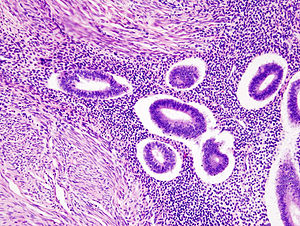Adenomyosis is defined as the presence of endometrial glands and stroma in the myometrium (muscle layer) of the uterus. It can be localized or diffuse (involving most of the uterus) and more commonly observed in parous women between the ages of 35-50. The exact cause of adenomyosis is unknown and may resemble fibroids on ultrasound, present with similar symptoms such as menorrhagia (excessive menstrual flow), dysmenorrhea (painful periods), enlargement of the uterus, pelvic pain and pressure. The severity of the symptoms increases proportionally to the depth of penetration and the total volume of disease in the myometrium.
Unlike adenomyosis, which appears as diffuse enlargement of the uterus, fibroids generally appear with a clear capsule and sharp margins on ultrasound examination, but in some cases the differentiation between the two can be difficult to make. In most instances (80%), adenomyosis is associated with fibroids or adenomyomas (exaggerated myometrial proliferation within the myometrial layer) and the mechanisms responsible may be similar to those for myomas. Removal of the fibroids only, may not resolve symptoms of heavy bleeding and pain in the presence of adenomyosis. In cases where the differentiation is difficult, MRI may be helpful to better identify the type of the uterine pathology, although it is still not 100% accurate and diagnostic. The diagnosis is confirmed by histological examination of the tissue after surgical removal.
There is no satisfactory proven medical treatment for adenomyosis, but a decrease in uterine size and bleeding may be observed with the progesterone containing intrauterine device (IUD). Hysterectomy is the definitive treatment for adenomyosis, but is not an option in women seeking fertility.
The association between adenomyosis and infertility is still unclear. It appears from the medical literature that removal of some or most of the adenomyotic tissue does not significantly change the success rates with IVF. In the presence of fibroids or adenomyomas, surgical removal of these lesions may be indicated, but in some cases there may be co-existing adenomyosis. In the event that adenomyosis is diagnosed during surgery, the general approach is to debulk (remove as much as possible) the diseased tissue and restore normal anatomy. In some of the cases, such a treatment may improve symptoms and in others if it does not and a pregnancy is desired, hysterectomy with preservation of the ovaries can be considered as the last option. In such severe cases, Dr. Bayrak recommends a gestational carrier be used along with In Vitro Fertilization (IVF) treatment.












